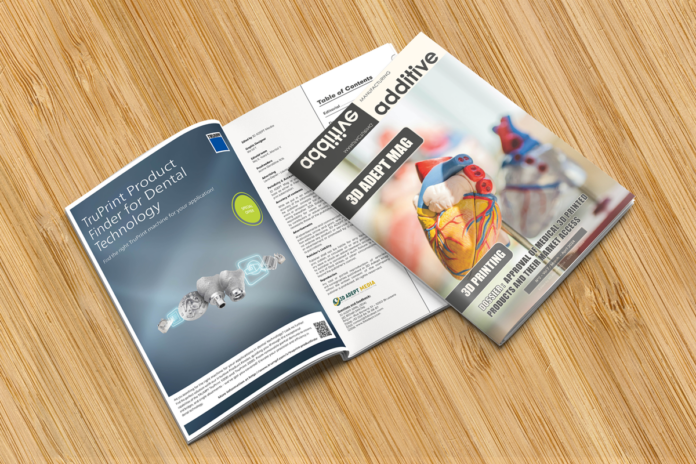When you know that an application or solution can change someone’s life, every explanation can be a real puzzle to demystify. Yet, this time it’s different, and that’s probably because we’ve been out in the field. We talked with users, and a few times, we met patients who were benefiting from 3D-printed solutions. In this issue of 3D ADEPT Mag, it’s this feedback from the field that we wanted to convey. We wanted to share these benefits: through industrial machine tests, the use of specific materials or AM solutions, feedback from doctors and medical experts, and even key information on the approval of 3D printed medical products and their access to the market. For once, the words to explain all these things easily came to us.
Exclusive features
DOSSIER | Approval of medical 3D printed products and their market access
For medical professionals in the field, it is sometimes unclear when a 3D printed device is considered a medical device and it’s hard to understand what a point of care (POC) 3D printing solution is. Beyond that, it is still confusing if relying on one or the other solution requires meeting a specific legal framework. This dossier ambitions to address these concerns.
AM Shapers | Current possibilities of Additive Manufacturing in the cranio-maxillofacial field
When we found out that the cranio-maxillofacial field of activity is the 7th out of 13 to benefit from Additive Manufacturing in reconstruction surgeries, we couldn’t help to ask ourselves the basic questions: What AM processes? How? Why? Given the limited number of European hospitals that rely on AM technologies for reconstruction surgeries, we reached out to Prof. Florian M. Thieringer from the University Hospital Basel, with the hope that his rich experience could help other healthcare providers take the leap on AM – or at least see this technology as a new opportunity to improve their art.
Software | The digital manufacturing stages of 3D printed patient-specific devices
At 12, Joe Johnson lost his leg in a motorcycle accident. He faced initial challenges with a basic prosthetic until he discovered how AM could help produce a tailor-made and more comfortable 3D-printed prosthetic. Johnson’s story could have ended after he got his first prosthetic, but he didn’t see anyone willing to take the risks to help amputees. His journey therefore led him to found Quorum Prosthetics, a prosthetics company that makes prosthetic arms and legs, custom bracing, and the Quatro adjustable 3D printed sockets. Over time, the company has been continuously exploring the use of digital manufacturing technologies to give amputees the right fit. If we are talking about it today, that’s because Johnson’s experience allowed us to understand the digital manufacturing stages of 3D-printed patient-specific devices.
Focus | Lithoz discusses the use of ceramic 3D printing for surgical tools and the importance of the right AM factory
If you’re a regular reader of 3D ADEPT Media, the name Lithoz should probably already ring a bell to you. With more than a decade of activities in the AM field, an acquisition, and three proprietary technologies (LCM, LIS, LSD Print), Lithoz’s work has been validated across three main vertical industries: medical, aerospace & space, and semiconductor. Of all these fields, the company has demonstrated that its market-leading LCM technology has become a promising production candidate in the healthcare & medical industries. The latest advancements in this article tell you why.
Focus | Solukon | The effect of piezoelectric excitation in an automated depowdering process: the case of medical 3D printed parts.
The more the market advances, the more new features are being developed and the more customers’ requirements become complex and stringent. At this point, a holistic experience that comes from a depowdering test might help tilt the balance in favor of one machine or another and confirm certification for use in a given industry or for a given application. To understand how such a test is being performed, we asked Solukon Maschinenbau GmbH something unusual: share insights into a depowdering test performed for one of their customers active in the medical and healthcare industries.
Post-processing | Volkmann GmbH on the concept of closed circuit in powder handling for 3D-printed parts
As we continuously explore the capabilities of the different solutions available on the market, we came to realize that Volkmann GmbH is one of those companies that advocate for the complete automation of this process.
Materials & Software | The potential of metamaterials for (medical) Additive Manufacturing
Remember when we said that the true success of an application usually depends on an underappreciated component: material? Well, the more AM advances, the more we realize that the array of opportunities materials offer are yet to be discovered. In this specific case, I am thinking of opportunities that necessarily intertwine innovative design methods and AM to ensure that optimum functionality and target behaviors are built into a new range of specialized materials. While a lot is being done at the research level, a Swiss startup gives hope for future commercialization of metamaterials.
Opinion | Going beyond healthcare needs with 3D printing
To optimize costs and the use of their 3D printing equipment, some healthcare providers may rely on creative ideas that enable professionals outside of the healthcare field to benefit from the advantages of Additive Manufacturing. The example of the France-based hospital CHU de Brest is one that’s worth mentioning here.
Events | Reflecting on two decades of Rapid.Tech 3D | Additive Manufacturing Hub
Here we are today, in 2024, reflecting on the opportunities that Messe Erfurt GmbH, the organizer of Rapid.Tech 3D, has been creating for the AM community over time.






